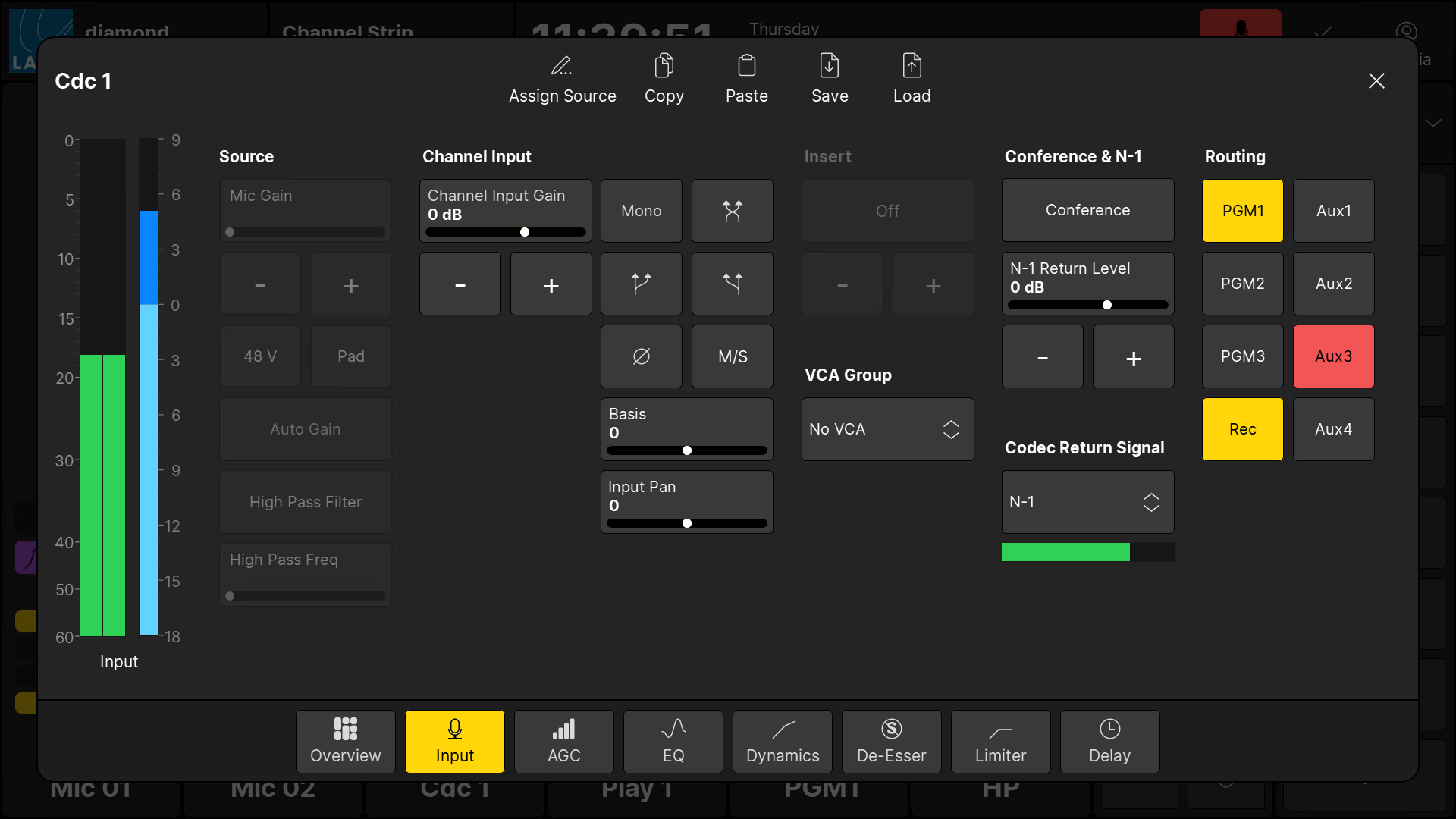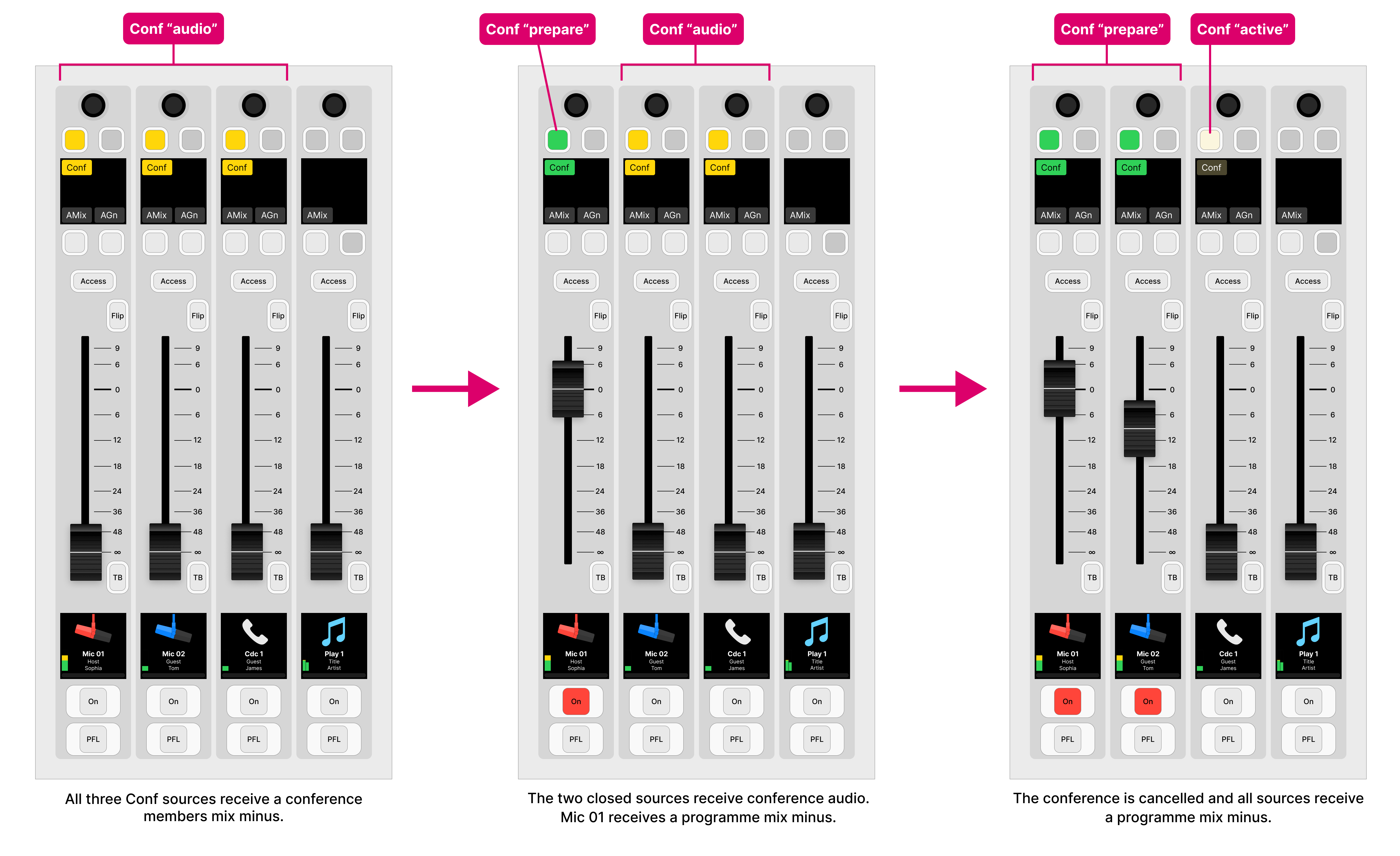diamond - Conference and N-1
The number of N-1/mix minus returns is determined by the configuration.
Usually there is a conference bus (for each return) that is assigned to a source (or sources).
Once active, each conference member receives a mix-minus feed that is switched automatically as follows:
- When the source fader is open (on-air), they hear all summed faders minus themselves.
- When the source fader is closed (off-air), they hear all members of the conference minus themselves. This allows sources to hear each other before they go on-air.
The rest of this topic describes the conference/N-1 returns defined in the standard configuration. The operation may vary if the configuration is customized.
Operation
In the standard configuration, each of the following sources supports a conference/N-1 return: Mic 1 to 8, Tel 1 & 2, Codec 1 to 6.
By default, each source receives PGM 1 minus themselves. Sources can be added to the conference system using the Conf keys (on the fader strips) or Conference buttons (on the GUI).
The N-1 return level can be adjusted (from the GUI), and talkback can be inserted by pressing the fader strip TB key.
Note that, for each codec source, it is possible to change the return signal (from the GUI). This allows you to send a sum bus or internal tone instead of the N-1 signal.
On the GUI...
1. Open the 'Source Parameter' dialog box by pressing a fader strip Access key, and choose the Input page.

2. Use the buttons under 'Conference & N-1' as follows. If an option is greyed out, then the parameter is not available.
- Conference - touch this button to add or remove the source from the conference system. The button colors are the same as on the surface (described below).
- N-1 Return Level - touch and drag anywhere inside the parameter box to adjust the N-1 level: either left/right or up/down. Or use the on-screen + and - buttons.
- Codec Return Signal - touch this field to select a signal from the dialog box. The following options are supported: N-1, PGM 1 to 3, REC, AUX 1 to 4 and Tone. The on-screen meter can be used to confirm that signal is present.
On the surface...
The Conf key adds (or removes) the source from the conference system. What the source receives depends on the status of the source fader and the other conference members.
The Conf key color indicates the current state. The colors used can be modified by the ON-AIR Designer. The following colors are used in the standard configuration:
- Dim white = conference off. Source receives PGM 1 minus themselves.
- Full green (Conf prepare) = conference on and fader open. Source receives PGM 1 minus themselves.
- Dim yellow (Conf active) = conference on and fader closed on a single source. Source receives PGM 1 minus themselves.
- Full yellow (Conf audio) = conference on and fader closed on more than one source. Source receives conference members minus themselves.
Conference System Example
In the example that follows, there are three conference members: Mic 01 (the host), Mic 02 (a studio guest) and Codec 1 (a phone-in guest).
When all three source faders are closed, the Conf keys turn full yellow and the sources can hear the other members of the conference but not themselves. This allows the conference members to chat off-air.
If you open the Mic 1 (host) fader, the source goes on-air. The Conf key turns full green, to indicate that this source is in "Conf prepare", and the source's N-1 return is switched back to a programme mix minus. The other two sources remain in "Conf audio". This allows the studio and phone-in guest to continue their off-air conversation. At any time you can close the Mic 1 fader so that the host can re-join the off-air conference.
If you open the Mic 1 (host) and Mic 2 (studio guest) faders, then two out of the three sources go on-air. The Conf keys turn full green, to indicate "Conf prepare", and each source's N-1 return is switched back to a programme mix minus. In this instance, there are less than two active conference members and so the conference is cancelled. The Cdc 1 source's N-1 return, for the phone-in guest, is switched back to a programme mix minus and its Conf key turns dim yellow to indicate "Conf active".
The image below shows how this looks on the surface.

At any time you can remove a source from the conference by deselecting its Conf key. The key turns dim white and the source's N-1 return switches back to a programme mix minus.